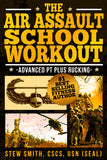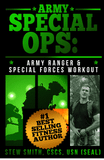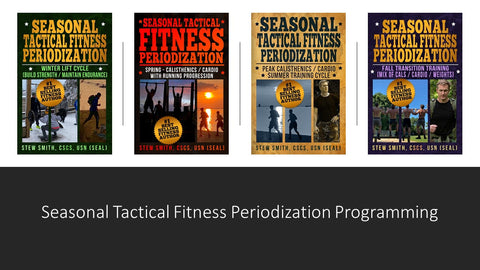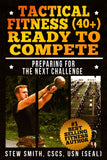Ever Wonder What a Competitive NSW Candidate Looks Like at the U.S. Naval Academy?
 It is highly competitive to obtain a Naval Special Warfare / SEAL billet out of the Naval Academy. Usually, each class has 120-150 "interested" candidates. After a series of pre-selection screeners, that number gets cut in half. These 70-80 Midshipmen candidates will attend SEAL Officer Assessment and Selection (SOAS) during the summer before their senior year. None of that will change. But the process to go from "interested in NSW" and attending SOAS has now started during their sophomore year.
It is highly competitive to obtain a Naval Special Warfare / SEAL billet out of the Naval Academy. Usually, each class has 120-150 "interested" candidates. After a series of pre-selection screeners, that number gets cut in half. These 70-80 Midshipmen candidates will attend SEAL Officer Assessment and Selection (SOAS) during the summer before their senior year. None of that will change. But the process to go from "interested in NSW" and attending SOAS has now started during their sophomore year.
Some History on the Changes Over the Years
Changes to the way the Naval Special Warfare Community selects Midshipmen at the Naval Academy are scheduled for implementation this year (2025). You can say it all started back in 2014 when the major changes led to the creation of the SOAS. This change made summer training programs at BUDS for Midshipmen more of an actual selection process versus a "summer cruise." In fact, before 2014, "Mini-BUD/S" was an exposure month for Midshipmen from the Naval Academy and ROTC units interested in attending SEAL training after graduation and commissioning. There was no selection process at Mini-BUD/S; it was simply a summer training program for Midshipmen to decide whether to attend after graduation, or to reconsider whether SEAL training was something they wanted to pursue. The actual selection process to attend BUD/S took place in the Fall, when the boards met for each of the service entry options: Service Academy, ROTC, OCS, and Lateral Transfers. The SEAL selection boards still meet in the Fall each year and will select the most qualified SOAS graduate.
The difference now is that a new command dedicated to recruiting, pre-training, and selecting candidates for SEAL training has been created. The Naval Special Warfare Assessment Command (NSWAC) evaluates candidates for entry into SEAL, SWCC, and other Naval Special Warfare programs. It assesses not only physical readiness through tests like the PST but also evaluates a candidate's aptitude for rigorous training and their mental resilience. The assessments are designed to identify those with the necessary skills and determination to excel in demanding special operations training.

More History Since 2014
Since the creation of SOAS, BUD/S instructors would travel to the Naval Academy to proctor roughly 150 Midshipmen through "the screener" during their junior year (Fall or Spring semester). Successful candidates then attended SOAS during the summer before their senior year. This process will largely remain the same, but the location of the screener will NOW be in Coronado, CA, at the BUD/S compound, during the early summer after the Midshipmen have completed their sophomore year. Then, after successful completion of "the screener", top applicants will be invited to attend SOAS the next summer before their senior year. Consider "the screener" more of an exposure weekend with a selection process included - sort of like a BUD/S Prep for Officer Candidates.
Just to be clear, the NEW process to attend BUD/S after graduating from the Naval Academy, you need to start the process early in your sophomore year at the Academy:
| Sophomore Fall / Spring Semester | Take the PST / HPT Combine (below) |
| End of Sophomore Year (May-June) | Attend the Screener at BUD/S |
| Summer Before Senior Year | Attend SOAS |
| November of Senior Year | Find out if selected to attend BUD/S |
| After graduation | Attend BUD/S |
Getting Accepted TO the Screener / SOAS
You will not get accepted to attend NSW summer training without crushing the fitness tests below (PST and a modified HPT). Now, you will not only take the Navy PST, but you will take a version of the Navy Human Performance Test (with some changes). Since the road to becoming a Navy Special Warfare member is long and challenging, you really want to be able to meet the physical standards. In fact, exceeding the standards IS the standard. There are no minimum standard goals that work in this journey. By understanding this, you'll have the foundation to continue preparing yourself to be the best candidate for selection that you can be.
Candidates with a history of participating in various sports may require less time to prepare for BUDS, as their conditioning is typically sustained at a high level. Training for scores like these will make you realize what IN SHAPE is and what is required of you going through any Spec ops Selection (specifically those that involve swimming and diving). These scores are above the average recommended scores for Midshipmen at the Naval Academy to be competitive. Work to score the following on the BUD/S Physical Screening Test (PST) (see link for clinic):
| The Navy BUD/S PST |
Recommended USNA Score |
|
500yd swim CSS |
8:20 or faster* |
|
Pushups 2 min |
90-100+ |
|
Situps 2 min |
90-100+ reps |
|
Pullups max |
20+ |
|
1.5 mile timed run |
9 minutes or faster* |
* Many top candidates get sub-8 min swim and sub-8 min run
Composite scoring system for the PST: Add run + swim time (seconds) subtract reps of pushups and situps and Pullups (x6). So, for this recommended composite score with the individual scores above would be: Swim = 500 seconds + Run = 540 seconds: 1040.
Subtract pushups and situps (100 each) 1040-200 = 840. Now, subtract 20 x 6 = 120 from 840 to get the composite score of 720. There will be scores in the 600s and perhaps even below, but these scores will put you in the top 20-30%.
At the Naval Academy, the HPT has been changed to the following events and personally recommended scores:
|
USNA HPT COMBINE |
Recommended Score |
|
BW Bench Press (max reps) |
15-19+ reps |
|
Trap Bar Deadlift (1-5 reps) |
1.5-2.2x bodyweight |
|
25lb WV Pullups |
10-15+ reps |
|
Standing Long Jump |
96-108 inches |
|
300yd (12 x 25yd) Shuttle |
65 seconds or less |
|
4-mile run |
28 minutes or faster |
Many top candidates will get sub 25 on the 4 mile, 20+ on pullups and bench and over 400 on the deadlift
I do not know of an official composite system for the HPT, but I have used a similar system to the PST Composite Scoring System for all types of tests when grading groups. Here is how I would rank candidates with this test (THIS IS NOT OFFICIAL)
Add Cardio/Speed Events Together
Add 4 miles timed run in seconds (28 x 60 = 1680)
Add 300yd shuttle run in seconds x 2 (65x2 = 130)
The cardio total score is: 1550
Two of the lifts get a x10 multiple added to them (pullups/bench)
Bench press 20 reps (x10)= 200 points
Pullups 20 reps (x10)= 200 points
Dead lift gets the weight lifted 400 lbs = 400 points (1 rep)
Standing Long Jump gets inches jumped 100 inches = 100 points
Add the strength/power section together to get: 900 points
Subtract strength/power from cardio 1550- 900 = 650.
Once again, this is just MY system of grading. The only issue is deadlift reps if done for more than 1 rep at that weight. You could reward the extra reps for those who get 2x bodyweight or above with an extra 10 points per rep if they do multiple reps? The other option is to not have a range for candidates. Set the standard at 1rm, 3rm, or 5rm and the weight stands on a 1:1 ratio to points given.
The two tests will be administered 2-3 days apart, and you are allowed to take them once a semester (fall and spring). This will be a major part of determining your acceptance into the Screener and SOAS in the upcoming summer training cycles. Your grades, conduct, extra-curricular activities, letters of recommendation, and leadership experience are also
part of the process to select Midshipmen to attend the Screener and SOAS the following Summer.
Extra Events You Can Self-Assess & Prepare for Screener, SOAS, BUD/S
The goal of self-assessment is to target weaknesses that you may have or may not know you have because you have never tried some of these events. You could have a basic technique issue or a more complex confidence or conditioning issue that requires time to address. You will be exposed to many of the following activities during the screener and SOAS, so be sure to practice the following events:
Simulate drownproofing: bobbing, floating, front flip, back flip, travel, mask retrieval in a nine-foot pool. In the Navy, this is done with hands and feet tied. Do not practice that. Simulate having your hands and feet tied. DO NOT PRACTICE ALONE OR TIE YOURSELF - ALL TESTS WILL BE SIMULATED TIED UNTIL BUD/S.
Ditch & Don - With fins, mask, and snorkel, dive to the bottom and take off and store all of the gear on the pool floor. Then surface, breathe 2-3 times, and dive back down to put on all of the gear (clear mask) and surface. DO NOT PRACTICE ALONE
Tread water: 10 minutes with no hands. Do this in a freshwater pool, rather than in the ocean. You will be less buoyant in fresh water, and that is how you will be tested. Learn how to tread with boots and utilities on. Additionally, treading water with fins while holding a 15-pound weight should be practiced. DO NOT PRACTICE ALONE
Rucking: Building on your base of running, you should be ready to add weight and participate in a ruck event once a week as a way to top off a leg day. If you have access to soft sand, use it. If not, find hills or stairs or bleachers to work the legs and lungs a little more. Shoot for a 10- to 12-minute mile with a 40- to 50-pound backpack. Also, build up to a chest carry by walking with the sandbaby (40-50lbs) for 1 mile without stopping.
Swim with SCUBA fins: Start to add distance to your swims with fins. It’s a great way to top off a leg-day routine. A swim of 1-2 miles with fins will be the normal distance at BUD/S. Practice at least once a week with fins at these distances.
Lunges: A chest-carry lunge with a 40-pound sandbag for 400 meters is a good set of lunges on a leg day. Do this on your leg day, and when you find you have no delayed-onset muscle soreness from this event, your muscle stamina in the legs is above average. Get comfortable doing chest carry walk/jogs with the 40-50lb sandbag as well.
Grip: Work on your grip as heavier guys (more than 200 pounds) tend to have grip issues on the obstacle course. See Operator Grip Circuit for ideas.
Spec Ops Triathlon (SOT): A good cardio base challenge is the four-mile run, four-mile ruck and the one-mile swim with fins workout. Mix that with a transition workout, such as the Sandbaby Murph or the Devil’s Mile (see below), and you have a good once-a-quarter, gut-check workout that is legit (and fun). Either one of these is a good standalone workout, but adding them as part of the SOT is a fun challenge.
Chamber’s Miles (aka the Devil’s Mile): This is four exercises that you perform for a quarter-mile each. It’s one of our favorites: 400-meter bear crawl, 400-meter walking lunges, 400-meter fireman carry (200 meters each partner), 400-meter burpee broad jump.
There is More To StewSmithFitness.com than You May Know
(In fact, there are more than 40 books, 1000+ articles, online coaching - and more)

Who is Stew Smith CSCS? Coach, Trainer, Writer, Podcaster: I'm the former Navy SEAL that tactical candidates go to for books, ebooks and online coaching to prepare themselves to get to and through intense tactical assessment and selection programs and qualify for service in their chosen tactical profession. See More at StewSmithFitness.com
Where to Find More Information About Optimal Performance Training Programs
When you start training again, consider the seasonal tactical fitness model. I call it A WAY to train and obviously not the only way to train. But it offers the opportunity to never neglect your weaknesses, helps with flexibility and mobility, but will also put you at a level of physical abilities where you are happy with your overall ability to do just about anything. We have a system where the seasons dictate our training. When it is nicer outside, we tend to run and do more calisthenics. When it is colder and not so nice, we lift more, run less, and still maintain our outdoor activities with shorter runs and rucks. Check it out: Seasonal Tactical Fitness Periodization System.
These Seasonal Tactical Fitness BLOCK Periodization programs will walk you through 4 x 4 weeks cycles with 16 weeks of each season in two programs. (32 total weeks)

Increase Strength & Crush the PST / IFT
3 Weeks Strength - 1 Week PT / Cardio Focus
(16 weeks)
The Specific Military / Special Ops Physical Fitness Workouts

Navy SEAL Workout Phase 1
Navy SEAL Workout Phase 2 - 3
Navy SEAL Workout Phase 4 Grinder PT
Navy SWCC Workout
Army / Air Force Advanced Fitness / Special Ops
Army PFT Workout (Prep For Rucking, OPAT, ACFT)
Army Special Forces / Ranger Workout
Army Air Assault School Workout
Army Airborne Workout
Air Force Special Warfare IFT / OFT / Selection Prep







Advanced Running Program - Special Ops Supplement Plan
USMC RECON / MarSOC Workout
USMC OCS / TBS Workout
USMC IST and PFT
The Combat Conditioning Workout
Air Force PJ / CCT Workout Battlefield Airman Prep Course
The UBRR Upper Body Round Robin Workout / Spec Ops version
The Coast Guard Rescue Swimmer / Navy SAR Workout
The Service Academy Workout (West Point, Navy, Air Force Academy)
The Navy, Air Force, Marine Corp Boot Camp Workout
The Law Enforcement Physical Fitness Workouts
The FBI Academy Workout | FBI Workout Vol 2
The DEA Workout
The FLETC Workout - Ace the PEB
The PFT Bible: Pushups, Sit-ups, 1.5 Mile Run
The Fire Fighter Workout - Ace the CPAT
Beginner / Intermediate / Advanced Fitness Guides
The Beginner / Intermediate Guide to Fitness
Reclaim Your Life Erin O'Neill Story (beginner / intermediate)
Veterans Fitness Baby Boomer and a Flat Stomach
Circuit Training 101 Beginner / Intermediate Guide to the Gym
The Busy Executive Workout Routine
The Obstacle Course Workout Prep for Races or Mil, LE, FF
TRX / Military Style Workouts Adding TRX to Military Prep Workouts
Tactical Fitness Over 40 Series
Tactical Fitness (40+) Phase 1, Phase 2, Phase 3, Phase 4
Online Coaching Options
Online PT CLUB - Weekly Workouts created personally for you.
New Member's Only Content / Services Program!
If you want access to years worth of workouts, many of the top eBOOKs, favorite workouts of the week, free fitness APP, closed Facebook Group, video / picture library of exercises, and more access to LIVE Q/A sessions check out the Stew Smith Fitness Members Section.
The dashboard below has the links to all the information, archives, videos, and links to workouts, podcasts, live Q and A lessons.
Consider this! - A Membership Program and Gain Access to Exclusive Content
(click for Fitness Club Dashboard - members only)
Questions? Just email - Stew@StewSmith.com
Stew Smith Fitness
Find more about our programs on our social media:
Instagram TikTok Youtube
Stew Smith is a former Navy SEAL and fitness author certified as a Strength and Conditioning Specialist (CSCS) with the National Strength and Conditioning Association. Visit his Fitness store if you're looking to start a workout program to get you TO and THROUGH any tactical fitness training program OR create a healthy lifestyle. Send your fitness questions to stew@stewsmith.com.





























